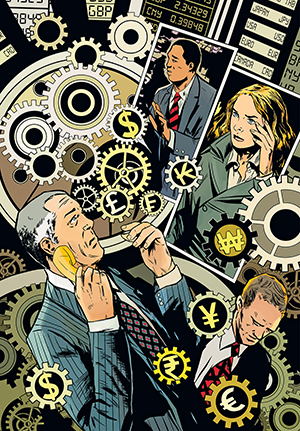As we step into an era marked by rapid technological advancements and
evolving economic paradigms, the concept of "money" is undergoing a
profound transformation. The money of the future promises to be more than just
a medium of exchange; it aims to be a versatile, secure, and efficient tool
that adapts to the needs of a digital and interconnected world. Let's explore
what the money of the future might look like and how we can benefit from it.
The Evolution of Money: From Cash to Digital
1. Traditional Currency
- Historically, money has evolved from commodity-based systems (like gold and silver) to paper currency and coins. This physical money served as a means of exchange, a store of value, and a unit of account.
2. Digital Money and Banking
- The digital revolution introduced electronic banking, credit/debit cards, and online transactions. These innovations made money transfers faster and more convenient but still relied on traditional banking systems and central authorities.
3. Cryptocurrencies and Blockchain
- The advent of cryptocurrencies, starting with Bitcoin, introduced a decentralized alternative to traditional currencies. Cryptocurrencies leverage blockchain technology to enable peer-to-peer transactions without intermediaries.
Characteristics of Future Money
1. Digital and Decentralized
o Cryptocurrencies: The future of money will likely involve a broader adoption of cryptocurrencies. These digital assets use blockchain technology to create a decentralized financial system. They offer benefits such as transparency, security, and reduced reliance on traditional banking intermediaries.
o Central Bank Digital Currencies (CBDCs): Governments worldwide are exploring CBDCs, digital currencies issued and regulated by central banks. CBDCs aim to combine the benefits of digital currencies with the stability of traditional money.
2. Smart and Programmable
o Smart Contracts: Future money may incorporate smart contracts—self-executing contracts with the terms written directly into code. These contracts automatically enforce and execute agreements when predefined conditions are met, reducing the need for intermediaries and lowering transaction costs.
o Programmable Money: This concept involves creating digital currencies that can be programmed to perform specific functions, such as automatically allocating funds based on certain conditions or tracking and managing assets in real-time.
3. Integrated with IoT
- Internet of Things (IoT): Future money will likely be integrated with IoT devices, enabling seamless and automated transactions. For example, smart appliances could automatically purchase supplies when needed, or vehicles could pay for tolls or fuel without human intervention.
4. Enhanced Security and Privacy
o Advanced Encryption: The money of the future will use advanced encryption techniques to ensure secure transactions and protect user privacy. Cryptographic advancements will enhance the security of digital wallets and reduce the risk of fraud.
o Privacy Coins: Some cryptocurrencies focus on enhancing user privacy by obfuscating transaction details. Future money might integrate similar privacy features to balance transparency with user confidentiality.
Benefits of Future Money
1. Increased Efficiency and Speed
- Digital and decentralized currencies can streamline transactions, making them faster and more efficient. Payments can be processed in real-time without the delays associated with traditional banking systems, which is particularly advantageous for cross-border transactions.
2. Reduced Costs
- By eliminating intermediaries and automating processes through smart contracts, future money can lower transaction fees and administrative costs. This can benefit both individuals and businesses by reducing overhead and making financial transactions more economical.
3. Financial Inclusion
- Digital currencies and blockchain technology can enhance financial inclusion by providing access to financial services for underserved and unbanked populations. Mobile wallets and digital currencies can reach people in remote or economically disadvantaged areas, offering them a gateway to the global economy.
4. Enhanced Security and Fraud Prevention
- The use of advanced encryption and blockchain technology will enhance the security of financial transactions. The decentralized nature of cryptocurrencies reduces the risk of systemic failures and fraud, while privacy features protect user data.
5. Programmability and Automation
- Programmable money and smart contracts enable automation of various financial processes, such as payments, compliance checks, and asset management. This automation reduces human error and increases the reliability of financial transactions.
 How to Benefit from the Money of the Future
How to Benefit from the Money of the Future
1. Embrace Digital Payments
- Start using digital payment methods and cryptocurrencies to familiarize yourself with their benefits and functionalities. Digital wallets and mobile payment apps offer a convenient way to manage and spend money.
2. Invest in Cryptocurrencies
- Consider diversifying your investment portfolio by including cryptocurrencies. Research different cryptocurrencies and blockchain projects to make informed investment decisions. Be aware of the risks and volatility associated with digital assets.
3. Adopt Smart Technologies
- Explore technologies that integrate with future money, such as smart contracts and IoT devices. These technologies can optimize your financial operations and offer new opportunities for automation and efficiency.
4. Stay Informed About CBDCs
- Keep an eye on developments in CBDCs and their potential impact on the financial system. Understanding how CBDCs might affect monetary policy, banking, and digital payments will help you navigate the evolving financial landscape.
5. Enhance Security Practices
- As digital and decentralized currencies become more prevalent, prioritize security practices to protect your digital assets. Use secure wallets, enable two-factor authentication, and stay informed about best practices for safeguarding your financial information.
Conclusion
The money of the future promises to be a transformative force in the world of finance, offering increased efficiency, reduced costs, and enhanced security. By embracing digital payments, investing in cryptocurrencies, and staying informed about emerging technologies, individuals and businesses can position themselves to benefit from these advancements. As we continue to navigate this evolving landscape, staying adaptable and proactive will be key to harnessing the full potential of the money of the future.
